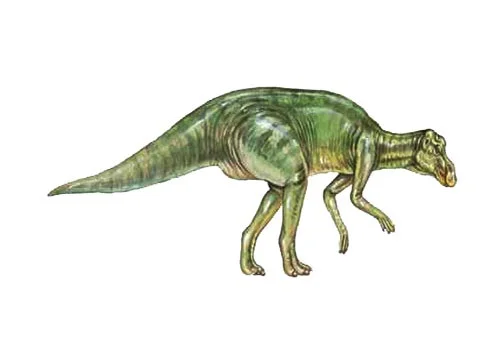Maiasaura (Caring/Good mother lizard)

My-ah-sore-ah
Jack Horner & Robert Makela - 1979
Herbivore
Estimated 9 meters long
Euornithopod
M. peeblesorum (type)
USA - Montana - Two Medicine Formation
Late Cretaceous, 80-75 million years ago
Maiasaura Facts
Maiasaura is a genus of dinosaur that lived during the Late Cretaceous period, approximately 75-80 million years ago, in what is now Montana and Alberta. Its name, Maiasaura, means “good mother lizard” or “caring mother lizard” in reference to the fact that it is the first dinosaur known to have cared for its young.
Maiasaura was a large, herbivorous dinosaur, growing up to 9 meters (30 feet) in length and weighing around 3 tons. It was a member of the hadrosaur family, also known as duck-billed dinosaurs, which were characterized by their flat, duck-like bills and large, grinding teeth used for processing tough vegetation.
One of the most notable aspects of Maiasaura is its parental behavior. In 1978, paleontologist Jack Horner and his team discovered a nesting site in Montana that contained thousands of Maiasaura eggs and the remains of hatchlings and juveniles. This discovery provided the first clear evidence of dinosaur parental care, as it appeared that the adult Maiasaura had cared for their young in a similar manner to modern birds.
Horner and his colleagues found that the nests were organized in a circular pattern, with the adults building nests out of vegetation and mud in which to lay their eggs. The parents then incubated the eggs and cared for the hatchlings by bringing them food and protecting them from predators. This type of parental care is similar to that seen in some modern birds, which are the descendants of dinosaurs.
Maiasaura is also an important dinosaur from an evolutionary standpoint. It was one of the first hadrosaurs to be discovered in North America, and its fossils have provided valuable insights into the anatomy and behavior of these fascinating animals. In addition to its parental behavior, Maiasaura is also known for its elaborate nasal passages, which likely played a role in vocal communication and social behavior.
Today, Maiasaura remains a popular and well-known dinosaur, and it has been featured in numerous documentaries, museum exhibits, and popular works of fiction. Its discovery and subsequent research have helped to transform our understanding of dinosaurs and their behaviors, and it has provided a fascinating glimpse into the lives of these ancient animals.



